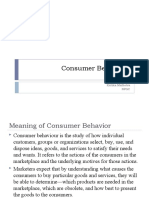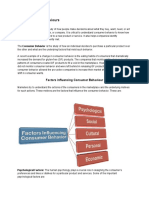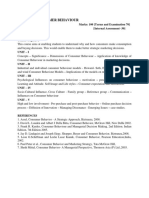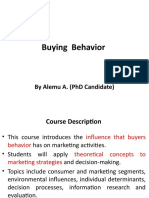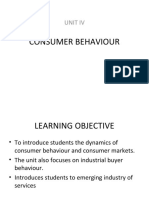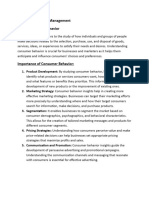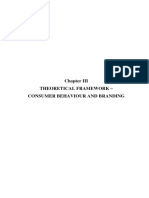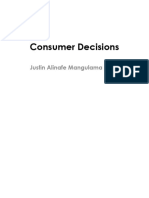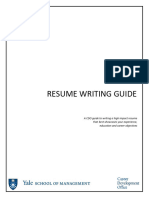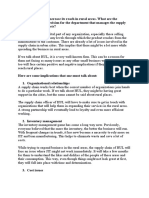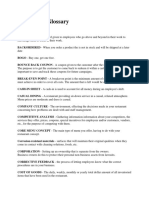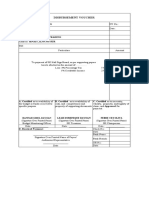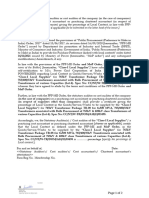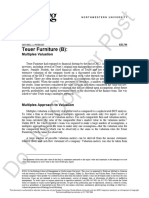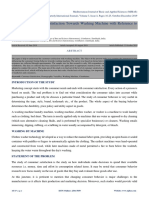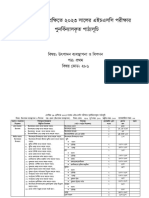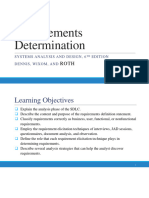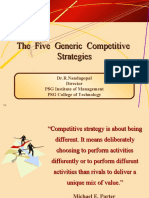Consumer behaviour-analysis
Presentation
By
Dr.Ben Mugerwa FCIM
� contents
• Definition of customer behavior
• Types of customers
• Characteristics of customers
• Factors influencing customer buying
processes
• The customer buyer behaviors
• The customer buyer centers
� Customer behavior
• Refer to patterns of response by a buyer
• It includes perceptions and attitudes to
buyers
� Types of customers
• A customer is an individual who buys
products for own consumption in order to
derive satisfaction eg households
• He is the last person in the distribution
channels
• An organisation : is the buyer who
purchases products to produce other
goods and services in order to derive
economic benefits eg schools etc
� Characteristics of customers
• Consumers:
• They buy in small quantities
• They buy frequently
• They buy for own satisfaction
• The buy process is short
• They buy at high prices
• They buy from intermediaries eg retailers
� organisations
• They buy infrequently
• They buy for economic satisfaction
• The buying process is long
• They buy at low prices
• They buy at low prices
• They buy from producers
• They buy in large quantities
� Factors influencing customer
buying processes
• Consumers:
• Culture;which is a belief, custom or norm of a
given society and this influences people`s
behaviors accordingly
• Sub-cultures eg religion can further influence
consumers buying habits eg moslems not eating
pork
• Social factors; arise from different groups eg
peers[colleagues], workmates, shopping mates,
leisure mates etc
�• Family;there are three families; family of
orientation where a person is born, family of
procreation-a person is married and extended
family where two or more people are staying
together without blood linkage
• Personality; people behave differently because
of factors like: perception, attitudes towards
products etc
• Psychological factors: factors arise from
individual `s own goals. Eg motives influence
individual` s behavior
� organisation
• Objectives of the organisation eg profit
• The demand for the product
• Competition in the environment
• Technology in environment
• Government actions like taxes
� The customer buying process
• Consumer:
• Identification of the need or problem by the
consumer eg being thirsty
• Searching for information about products from
friends, customers, sales people etc
• Evaluation of information on different products
basing on prices, quantity, convenience etc
• Actual purchase; buying the best product
• Post purchase behavior:evaluating to find out
whether the product solved the problem or not
�• Organisation:
• Identification of a need or a problem
• Determining product characteristics
• Identifying the suppliers
• Soliciting for proposals from suppliers
• Evaluation of proposals
• Actual purchase of the product-communication
to the best supplier to supply the product
• Post-purchase behavior
� The buyer behaviors
• Consumer:
• Complex buying behavior;product is
expensive wide band difference hence
calls for high consumer involvement eg
cars, houses, etc
• Dissonance reducing buying behavior;
product is expensive limited brand
difference and calls for high consumer
involvement eg carpets, suits etc
�• Variety seeking buying behavior; products
are cheap, wide brand difference and very
low consumer involvement eg tooth paste,
bathing soap etc
• Habitual buying behavior; products are
cheap limited brand difference and call for
low consumer involvement eg sugar, salt
etc
�• Organisation:
• New task-when the organisation is buying
for the first time
• Straight re-buy when the organisation is
repeating purchase but from a different
supplier
� The customer buyer centres
• Consumer:
• Initiators; people who originate the idea of
buying
• Influencers; people who catalyze the idea of
buying
• Deciders; the people who decides whether the
product should be bought or not
• Purchasers; a person who buys the product
make the decision of what and where to buy
• Users; those who finally use the product
�• Organisation:
• Initiators: people who originate the idea of
buying
• Influencers: people who decides whether the
product should be bought or not
• Purchasers: a person who buys the product,
make the decision of what and where to buy
• Users: those who finally use the product
• Gate keeper: those who control the inflow and
out flow information













